One of the most effective ways for keeping our senior selves healthy and active is trampoline exercise. Yes, you heard me right! Trampolining isn’t just for kids anymore. It’s a fantastic way for us seniors to stay fit and have some fun while we’re at it.
Gentle bounces, graceful movements, and a whole lot of health benefits, everything is good for seniors if performed properly.
We’re talking about exercises that are easy on the joints, improve balance, and even boost cardiovascular health. Plus, who wouldn’t want to feel like a kid again, bouncing around carefree? But, before we start jumping for joy, let’s talk about why they are beneficial.
We’ll cover how to make sure we’re staying safe while we bounce, including being mindful of any physical limitations and keeping an eye out for those younger jumpers.
So, are you ready to discover the joys of trampoline exercise for seniors? Let’s bounce into it together!
Why Is Trampoline Exercise for Seniors Beneficial?
Many of you don’t understand why trampoline exercise is such a boon for seniors. For sure, there are lots of benefits of gently bouncing on a trampoline, feeling the rhythm of your body moving in a low-impact, effortless motion.
Here’s why it’s so beneficial:
Joint-Friendly
Unlike high-impact exercises like jogging or aerobics, trampoline exercise puts minimal stress on your joints. This means less discomfort and fewer chances of aggravating any existing joint issues.
Improved Balance
As we age, maintaining balance becomes crucial to prevent falls and injuries. Trampoline exercises engage your core muscles and help improve your balance and stability, making everyday movements safer and easier.
Cardiovascular Health
Jumping on a trampoline gets your heart pumping and blood flowing, which is excellent for your cardiovascular health. It’s like giving your heart a gentle workout without the strain of more intense exercises.
Bone Density
Did you know that bouncing on a trampoline can actually help increase bone density? The repetitive, low-impact nature of trampoline exercise stimulates bone growth, which is particularly important for seniors at risk of osteoporosis.
Fun and Engaging
Let’s face it, traditional workouts can sometimes feel like a chore. Trampoline exercise, on the other hand, is a blast! It’s a playful and enjoyable way to stay active, which means you’re more likely to stick with it long term.
Stress Relief
Bouncing on a trampoline can be incredibly freeing and liberating. It’s a chance to let go of stress and worries, even if just for a few minutes, and focus on the simple joy of movement.
So, there you have it, trampoline exercise offers a host of benefits for seniors, from joint-friendly workouts to improved balance and cardiovascular health. It’s time to bounce into better health and vitality!
8 Most Effective Trampoline Exercises for senior
Now, let’s explore eight effective trampoline exercises tailored specifically for seniors. From gentle bounces to balance challenges, each exercise offers unique benefits to enhance strength, balance, and overall well-being.
However, make sure to properly check how to try this exercise before you try them. Here are all you need to know:
1. Health Bounce
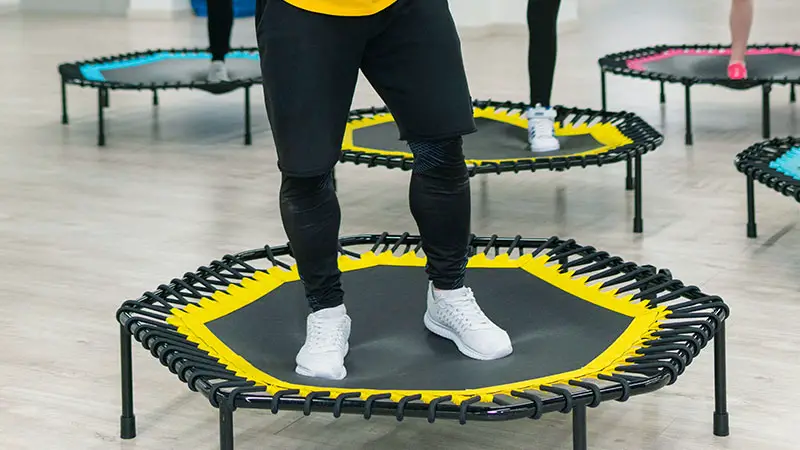
The Health Bounce is a foundational trampoline exercise for seniors, providing a gentle yet effective way to improve circulation, lymphatic flow, and joint mobility.
This exercise is particularly beneficial for seniors because it’s low-impact, reducing strain on joints and muscles while still promoting cardiovascular health and overall well-being.
How to try the workout:
- Stand with feet hip-width apart on the trampoline.
- Hold a small deflated ball between your inner thighs for added stability.
- Begin to bounce gently, allowing your heels to lift off the trampoline surface.
- Keep your movements controlled and rhythmic, focusing on the upward motion to engage your muscles.
- Aim for a duration of 5-10 minutes, gradually increasing as your stamina improves.
2. Balance Rebounding Exercise
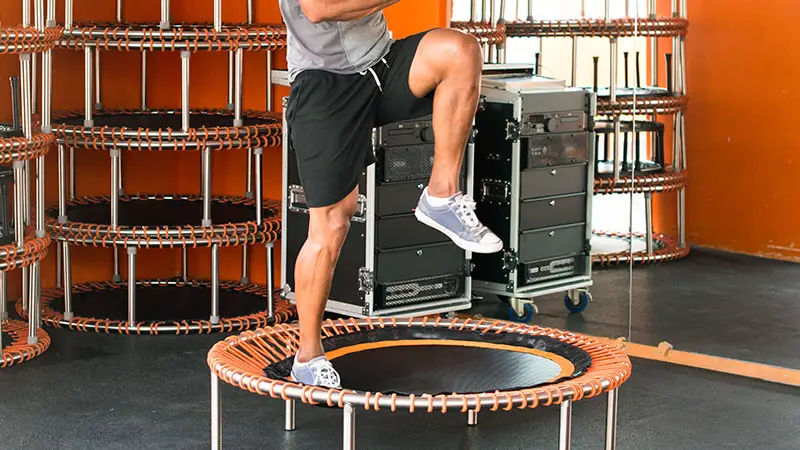
Balance becomes increasingly important as we age to prevent falls and maintain mobility. This exercise helps seniors improve balance and coordination by challenging the body’s stability in a controlled environment.
It also engages core muscles, which are vital for maintaining posture and stability.
How to try the workout:
- Stand on the trampoline with feet hip-width apart.
- Extend your arms out to the sides for balance.
- Lift one leg in front of you while keeping the other foot firmly planted.
- Hold for a few seconds, then switch legs.
- Repeat for several repetitions, gradually increasing as you feel more confident.
3. High Intensity Rebounding Exercise
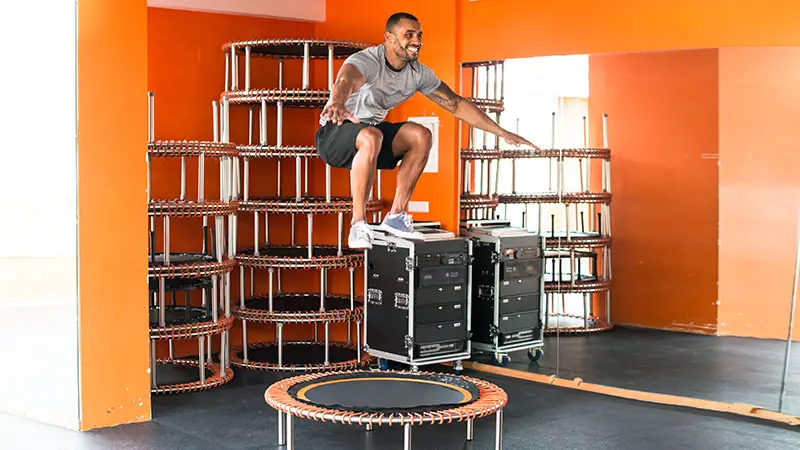
High-intensity exercises like dancing, point-jogging, or jumping jacks on a trampoline can help seniors improve cardiovascular health and endurance.
By elevating the heart rate and engaging multiple muscle groups, this workout promotes fat burning and overall fitness.
How to try the workout:
- Start with a gentle warm-up, such as a few minutes of Health Bounce.
- Gradually increase the intensity by incorporating aerobic moves like dancing or jumping jacks.
- Focus on maintaining proper form and breathing rhythmically throughout the workout.
- Aim for 15-20 minutes of high-intensity rebounding, gradually increasing duration as your fitness level improves.
4. Low Impact Bouncing Exercise
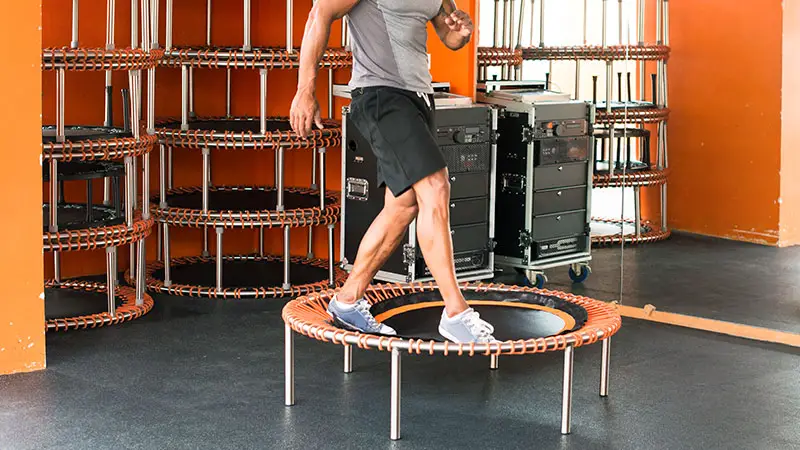
This exercise focuses on the rebounding motion without lifting the feet from the trampoline surface, making it ideal for seniors with joint issues or mobility concerns. It promotes lymphatic drainage and circulation while minimising stress on the joints.
How to try the workout:
- Stand with feet hip-width apart on the trampoline.
- Begin to bounce gently, focusing on the upward motion without lifting your feet off the surface.
- Keep your movements controlled and rhythmical, engaging your core muscles.
- Aim for a duration of 10-15 minutes, gradually increasing as your stamina improves.
5. Back Kick Rebounding Exercise
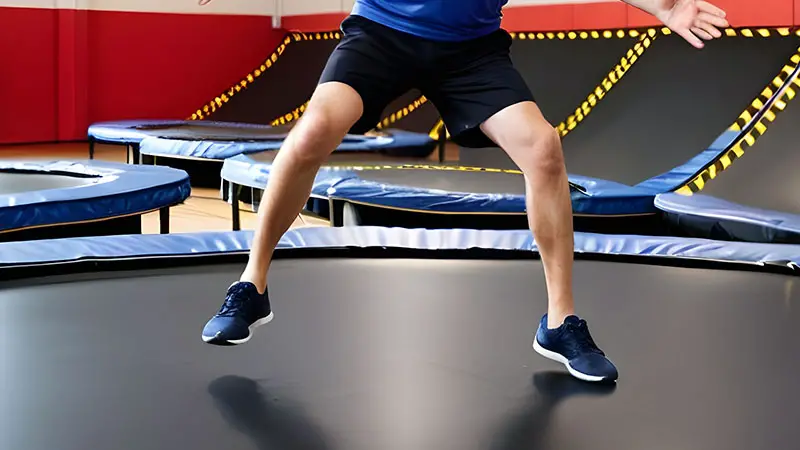
Back kicks on the trampoline help strengthen the shoulders, buttocks, and legs while improving flexibility and range of motion. This exercise also targets the abdominal muscles, promoting core strength and stability.
How to try the workout:
- Stand on the trampoline with feet hip-width apart.
- Engage your core muscles and maintain a slight bend in your knees.
- Kick one leg backward, aiming to touch your buttocks with your heel.
- Return to the starting position and repeat on the other leg.
- Continue alternating legs for several repetitions, gradually increasing speed and intensity.
6. Toe Touch Trampoline Balance Move
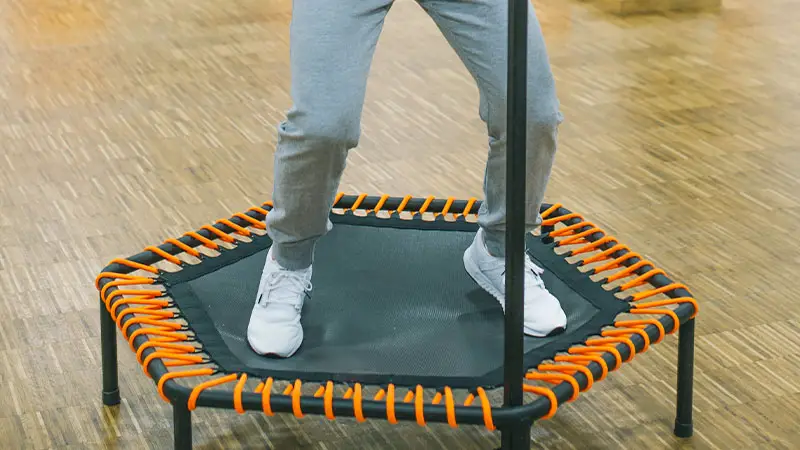
This exercise challenges balance and coordination by requiring seniors to lift one foot off the trampoline surface while tapping the frame in front and to the sides. It also strengthens the muscles of the lower body and improves proprioception.
How to try the workout:
- Stand on the trampoline with feet hip-width apart.
- Lift one foot off the surface and extend it forward, tapping the front of the frame.
- Return to the starting position and tap the frame to the side with the same foot.
- Repeat on the opposite side, alternating legs for several repetitions.
- Focus on maintaining stability and control throughout the movement.
7. Straight Ahead Hold Trampoline Balance Move
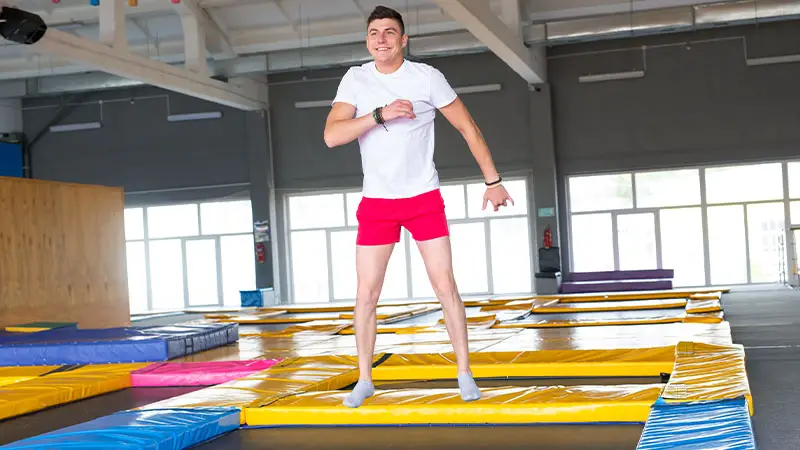
This exercise targets balance and stability by challenging seniors to lift one foot straight out in front of them while keeping the other knee slightly bent. It also engages the core muscles and promotes proper posture.
How to try the workout:
- Stand on the trampoline with feet hip-width apart.
- Lift one foot straight out in front of you, keeping the knee slightly bent.
- Hold this position for a few seconds, engaging your core muscles for stability.
- Lower the foot back to the starting position and repeat on the opposite side.
- Aim for several repetitions on each leg, gradually increasing the duration of the hold.
8. Cool Down Breaths

Cooling down with deep breathing exercises helps seniors relax both mentally and physically after a trampoline workout. It promotes stress relief, reduces muscle tension, and aids in recovery.
How to try the workout:
- Sit or lie down in a comfortable position on the trampoline.
- Close your eyes and take slow, deep breaths in through your nose and out through your mouth.
- Focus on releasing any tension or stress with each exhale, allowing your body to fully relax.
- Continue breathing deeply for 5-10 minutes, allowing yourself to fully unwind and recharge.
By incorporating these 8 effective trampoline exercises into your routine, seniors can enjoy improved balance, strength, cardiovascular health, and overall fitness while minimising the risk of injury and strain.
Remember to start slowly, listen to your body, and gradually increase intensity as you feel more confident. Happy bouncing!
Trampolining Safety Concern for Seniors
Trampolining can be a fantastic way for seniors to stay active, but it’s essential to address safety concerns to prevent accidents and injuries. Here are some key risk factors and how to mitigate them:
Physical Limitations
Seniors may have existing orthopedic injuries, heart issues, or blood pressure concerns that could be exacerbated by trampoline exercise.
It’s crucial to consult with a healthcare professional before starting any new exercise regimen to ensure it’s safe for your individual health status.
Distractions
Seniors may be more prone to distractions due to cognitive impairments or sensory changes. It’s essential to maintain focus and concentration while on the trampoline to prevent accidents.
Choose a quiet, distraction-free environment for your workout, and avoid multitasking while bouncing.
Presence of Younger Jumpers
Trampoline parks or shared spaces may have younger jumpers who can be unpredictable or unaware of seniors’ limitations.
Be mindful of your surroundings and communicate with other jumpers to prevent collisions. Consider visiting trampoline parks during off-peak hours when there are fewer crowds.
Proper Landing Techniques
Seniors may be at increased risk of joint injuries if they land improperly or lose balance while bouncing.
Practise proper landing techniques, such as bending your knees upon landing and keeping your feet shoulder-width apart to absorb shock. Start with low-impact exercises and gradually increase intensity as your confidence and strength improve.
Slipping Hazards
Trampoline surfaces can become slippery, especially when wearing regular socks. Invest in non-slip grip socks or trampoline shoes to improve traction and reduce the risk of slipping.
Additionally, ensure the trampoline surface is clean and free of debris or moisture before each use.
These safety concerns and appropriate precautions are essential for seniors to enjoy trampolining safely and reap the numerous health benefits it offers. Always prioritise your well-being and listen to your body during exercise to prevent accidents and injuries.
What Type of Trampoline Is Good for Seniors?
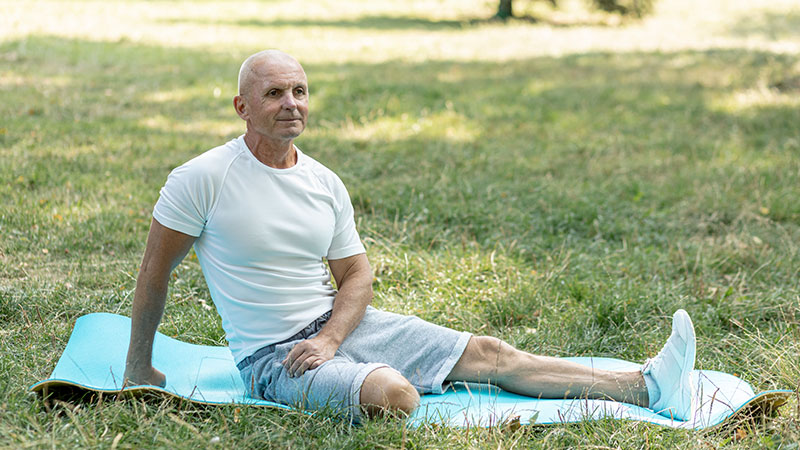
For seniors, a rebounder or mini trampoline is typically the best option. Rebounders feature an elastic surface that provides low-impact bouncing, reducing strain on muscles and joints.
These trampolines are ideal for seniors because they offer a safe and effective way to improve balance, flexibility, strength, and overall fitness without putting excessive stress on their bodies.
Additionally, rebounders are convenient for seniors as they do not require much space, are lightweight, and easy to move around. This makes them suitable for home use, allowing seniors to exercise in the comfort of their own space.
When selecting a rebounder for seniors, it’s essential to choose one with a sturdy frame and a high-quality, durable mat to ensure safety and longevity. Here are some facts you need to consider:
- Consider low-impact options like rebounders or mini trampolines.
- Ensure the trampoline has a sturdy frame and a high-quality mat for safety.
- Look for adjustable tension settings to customise the bounce intensity.
- Opt for models with padded handlebars for added stability and support.
- Choose a trampoline that fits your space constraints and is easy to move if needed.
- Prioritise comfort and ease of use to encourage regular exercise sessions.
- Consult with a healthcare professional before starting any new exercise regimen, especially if you have pre-existing health conditions.
Wrapping Up
Trampoline exercise offers a wealth of benefits for seniors, providing a fun and effective way to stay active and maintain overall health and well-being.
From improving balance and coordination to boosting cardiovascular health and bone density, trampoline workouts cater specifically to the needs of older adults, offering low-impact yet impactful movements that are gentle on the joints.
Furthermore, the variety of exercises available on a trampoline allows seniors to tailor their workout to their individual fitness levels and preferences, ensuring a personalised and enjoyable experience.
Whether it’s the gentle Health Bounce or the more challenging High Intensity Rebounding Exercise, there’s something for everyone to enjoy.
However, it’s crucial for seniors to prioritise safety while engaging in trampoline exercise, taking into account their physical limitations and surroundings.
By following proper techniques, wearing appropriate footwear, and being mindful of potential hazards, seniors can minimise the risk of accidents and injuries while maximising the benefits of their trampoline workouts.
Overall, trampoline exercise offers seniors a unique opportunity to stay active, improve their fitness, and enhance their quality of life. So, why wait? Let’s bounce into better health together!
I am a fitness instructor and I have been in the industry for 9 years. I have a passion for health and fitness.
I am a fitness instructor with over 9 years of experience in the industry. My passion is health and fitness and I would love to share my knowledge with you!